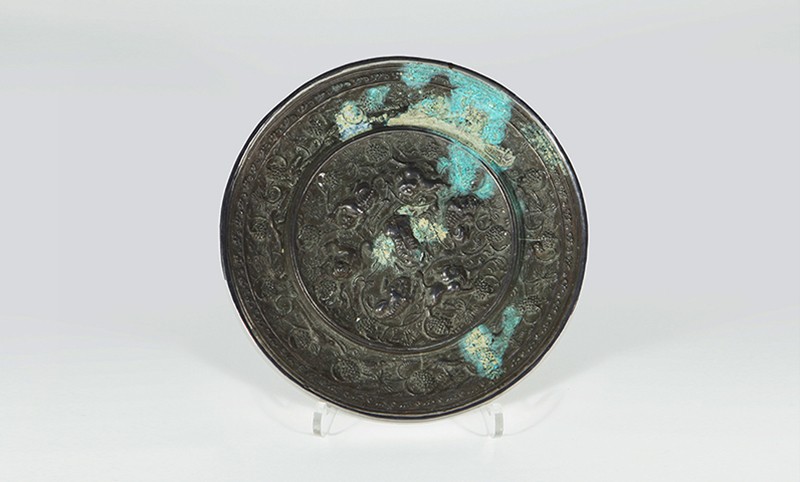 |
Mirror with Animal, Leaf, and Fruit Designs, Tang Dynasty (618-907)
Han culture; China
Bronze and silver; 1/2 x 6 1/8 in.
2005.28.1
In Memory of Armand J. Labbe |
The World in Bronze
Mirrors today are multi-layered compositions of metal and glass, but historically the only requirement was a reflective surface. In China, a country whose complex manufacturing tradition dates back thousands of years before the Common Era, the earliest mirrors were made from highly polished bronze with one side a flat, reflective surface and the other side highly decorated with some sort of knob to be gripped. Well-regulated by imperial officers, these mirrors would have been pervasive in the private spaces of early dynastic China as highly portable reminders of prestige and one’s own appearance.
 |
Mirror, Warring States Period (403-221 BCE)
Han culture; China
Bronze; 1/4 x 5 1/2 in.
2000.65.5
Gift of Heather Sacre |
After Image
The very earliest mirrors in China show up among the Quija culture living along the upper regions of China’s Yellow River between 2200 and 1600 BCE. Visually very similar to the mirrors created thousands of years later, signature aspects such as one flattened side and one decorated side, and a holed knob for the mirror to be held or hung were already present. Through a slow-moving osmosis, this style of mirror began to appear in regions controlled by China’s Shang dynasty in following centuries—almost certainly a result of trade rather than Chinese manufacture. It is difficult to pinpoint exactly when the first Chinese-made bronze mirrors were produced, but evidence points to shortly before the beginning of China’s Warring States Period in 475 BCE. In both the Warring States Period and particularly the Qin and Han dynasties the process for bronze mirror manufacture was formalized and regulated by imperial officers. Between the fall of the Han dynasty in 220 CE and the beginning of the Tang dynasty in 618 CE was a relative lapse in manufacture. Following the end of the Tang dynasty, the same decline in quality was seen, the result being that most of the most impressive Chinese bronze mirrors that exist today were made during either the Han or Tang dynasties.
 |
Mirror, Han Dynasty (206 BCE-220 CE)
Han culture; China
Bronze; 1/4 x 4 5/16 in.
2000.65.8
Gift of Heather Sacre |
No Less Than Alchemy
It is no coincidence that much of what we know about early Chinese bronze mirrors’ manufacturing process comes from the Han and Tang dynasties—the same government officials charged with quality control published reports outlining each step involved in production. During the Han dynasty the process began with the mining of copper, tin, and lead. These materials were transported to workshops overseen by the Directorate for Imperial Manufactories—a bureau founded during the Qin dynasty to supervise alchemists, magicians and bronze casters. At these workshops a standard composition of 71% copper, 26% tin and 3% lead was mixed and poured into a two-piece mold made from clay. The benefit of the compound was that it captured fewer of the gases produced during the process, making for fewer imperfections in the surface of the mirror. When cooled in the pottery-wheel-made mold, the resulting surface was almost perfectly flat and could be polished to an incredible degree of reflectivity.
 |
Mirror with Sculpted Anthropomorphic Figures, Han Dynasty (206 BCE-220 CE)
Han culture; China
Bronze; 5/16 x 4 5/8 in.
2000.65.4
Gift of Heather Sacre |
Tin Men Defying Tin Men
Despite the great deal of information and control regarding the manufacture of Chinese bronze mirrors, identifying the geography or period in which a mirror was made is complicated by forgeries dating as far back as originals. It was well-known at the time that bronze mirrors created in government-supervised workshops were higher quality than those created in smaller workshops in terms of material composition and reflectivity. As a result, many mirrors are inscribed as having been made at a workshop under the control of the Directorate of Imperial Manufactures, but this might not necessarily mean the mirror was created in one of the workshops around the capital city of Chang'an, modern-day Xi-an, that was overseen by the directorate. The same is true of dated mirrors, which came to be common practice during the Han dynasty. In rare cases, mirrors dated as having been made in auspicious years can be outed as later forgeries by looking at calendrical inconsistencies.
 |
Mirror with Animal, Leaf, and Fruit Designs, Tang Dynasty (618-907)
Han culture; China
Bronze; 3/8 x 5 3/8 in.
2005.34.1
Gift of Dr. Stephen Blair in memory of Armand J. Labbe |
Motifs in Metal
While the standardized manufacture of bronze mirrors made them easy targets for forgeries, the process also makes the designs of the mirrors easy to identify as hundreds of mirrors with the same designs might have been made. The earliest design featured in this post dates from the Warring States period. Four symbols for the word mountain (shan 山) serve as the main decorative elements surrounded by floral motifs. The geometric mirror surrounded by a band of raised semi-circles is a variation on a constellation design seen during the Western Han dynasty. The chronologically third unique design in this post features anthropomorphic motifs representing deities. In similar examples the inscription is a wish for the lordship’s office and happiness to be protected by these divine guardians. Lastly, two of the Bowers’ mirrors feature the same design with a central lion surrounded by six more lions. This design was first popularized in the early Tang dynasty, having evolved out of a less-ornate design from the prior Sui dynasty.
Text and images may be under copyright. Please contact Collection Department for permission to use. References are available on request. Information subject to change upon further research.






Comments 1
Hello,
These Blogs are very informative and entertaining.
Who writes them?
Thank you.